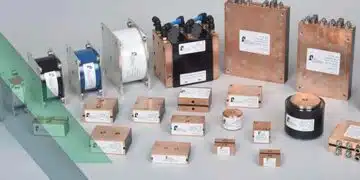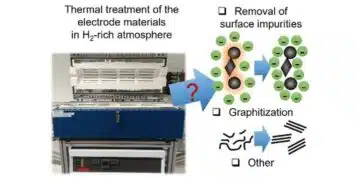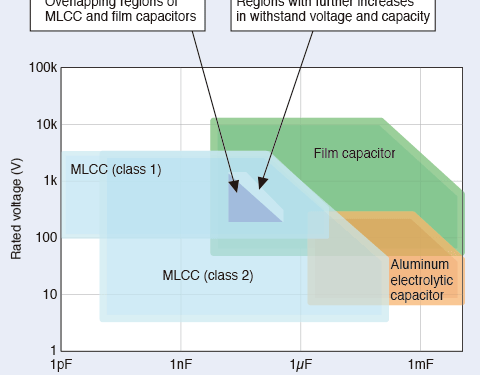source: TDK news
TDK published a technical note guide for replacing of film capacitors with C0G MLCC.
Vol.1 Features of High voltage MLCCs with C0G Characteristics and Replacement Solutions Overview
A wide variety of capacitors, each with their own special characteristics, are used in electronic devices. Generally speaking, the capacitance and withstand voltage (rated voltage) of capacitors are in a trade-off relationship which is difficult to balance. In MLCC of the same size, when increasing the withstand voltage, the capacitance tends to decrease.
Film capacitors possess a good balance of high withstand voltage and capacitance. Since they also possess outstanding frequency characteristics and temperature characteristics, they are widely used in automotive electronics, industrial equipment, home appliances, etc.
However, in recent years, there have been remarkable increases in withstand voltage and capacitance in MLCCs (multilayer ceramic chip capacitors) for temperature compensation (class 1). In particular, even in fields where film capacitors have traditionally been used, resonance circuits for example, replacement with MLCC is now possible. TDK has developed high voltage MLCCs with C0G characteristics. Through C0G characteristics, these MLCCs achieve withstand voltage of 1000V at the broadest capacitance range (1nF to 33nF) in the industry.
In this guide, we explain the numerous benefits of replacement while comparing the features of high voltage C0G MLCCs with those of film capacitors.
Characteristics of main capacitors
MLCCs are divided into two major categories according to the type of ceramic materials used for their dielectric, namely class 1 (temperature compensating) and class 2 (high dielectric constant).
Class 2 MLCCs have a large capacitance. However, they also have a disadvantage in terms of a large capacitance change caused by temperature. On the other hand, while class 1 MLCCs do not offer as high a capacitance as class 2, they display a smaller capacitance change caused by temperature. They also possess outstanding frequency characteristics and are used in circuits which require high precision.
Figure 1 shows the corresponding regions for rated voltage-capacitance in main capacitors: aluminum electrolytic capacitors, film capacitors, and MLCCs (class 1 and class 2).
Figure 1: Corresponding regions of rated voltage-capacitance for different capacitors

Table 1 summarizes a comparison of the characteristics of aluminum electrolytic capacitors, film capacitors, and MLCCs.
Table 1: Comparison of characteristics in main capacitors
| Aluminum electrolytic capacitor |
Film capacitor |
MLCC (class 1) |
MLCC (class 2) |
|
|---|---|---|---|---|
| Large capacitance | ◎ | ○ | △ | ○ |
| Withstand voltage | ○ | ◎ | ○ | ○ |
| Temperature characteristics | △ | ◎ | ◎ | △ |
| Frequency characteristics | △ | ◎ | ◎ | ◎ |
| DC bias characteristics | ◎ | ◎ | ◎ | △ |
| Ripple resistance | △ | ◎ | ◎ | ◎ |
| Moisture resistance | ○ | ○ | ◎ | ◎ |
| Lifespan/reliability | △ | ◎ | ◎ | ◎ |
| Compact size | △ | △ | ◎ | ◎ |
◎: Outstanding ○: Good △: Relatively poor
The advantage of aluminum electrolytic capacitors is their large capacitance. In terms of other characteristics, film capacitors and MLCCs are superior. Unlike class 1 MLCCs, it is difficult to achieve compact size for film capacitors. The table also shows how it is difficult to increase the capacitance and withstand voltage of class 1 MLCCs.
The capacitance value of class 2 MLCCs changes greatly with changes in temperature. In comparison, class 1 MLCCs exhibit a nearly linear change. The straight line slope in relation to temperature is called the “temperature coefficient.” It is expressed in units of [ppm/°C].
In JIS and EIA standards, the temperature coefficient value and the related tolerance are categorized into classes. The strictest EIA standards for C0G MLCCs (class 1) require a temperature coefficient of 0 ppm/°C and a tolerance of ±30 ppm/°C at a temperature range of -55 to +125°C. Figure 2 shows temperature characteristics (changes in capacitance due to temperature change) for film capacitors and MLCCs.
Figure 2: Comparison of temperature characteristics (changes in capacitance due to temperature change) in C0G MLCCs and various capacitors

As clearly shown by the graph, C0G MLCCs have extremely stable temperature characteristics when compared with X7R MLCCs (class 2), U2J MLCCs (class 1), and various film capacitors.
Reason why C0G MLCCs are used in resonance circuits
The resonance frequency (f) of LC resonance circuits with a combination of capacitors and coils (inductors) is expressed by the formula f=1/2π√LC, where C is the capacitance of the capacitor, and L is the inductance of the coil. As shown by this formula, changes in the capacitance of the resonance capacitor (capacitor in a resonance circuit) cause changes in the resonance frequency. When the resonance frequency does not remain stable and fluctuates, warping occurs in the waveform transmitted and the energy transmission efficiency decreases.
For this reason, film capacitors which are relatively stable in relation to temperature change have normally been used in resonance circuits for automotive electronics and other devices with large currents at high voltages.
Also shown by the formula above, capacitors with even larger capacitance are required as the resonance frequency decreases. The resonance frequency for resonance circuits of automotive electronics is set to a range of several tens kHz to several hundreds kHz, and film capacitors with both a high withstand voltage and capacitance were most suitable for this usage.
However, as stated earlier, the withstand voltage and capacitance of class 1 MLCC is increasing rapidly in recent years, and more and more manufacturers are replacing film capacitors with C0G MLCCs as a result. MLCCs are smaller than film capacitors, and so have the advantages of increasing transmission efficiency through high-accuracy resonance and compact size.
Table 2 shows a comparison of temperature range, moisture resistance, external shape, and size of film capacitors (PP: Polypropylene) and C0G MLCCs.
Table 2: Comparison of main specifications for film capacitors and C0G MLCCs
| Film capacitor A (PP) |
Film capacitor B (PP) |
C0G MLCC |
|
|---|---|---|---|
| Temperature range | -40 to +105°C |
-40 to +105°C |
-55 to +125°C |
| Moisture resistance | 40°C/ 95%RH |
60°C/ 95%RH |
85°C/ 85%RH |
| External shape, size | Lead terminal, large size |
Lead terminal, Medium size |
SMD, small size (lead terminal also exists) |
continue reading at the TDK site after registration here

































